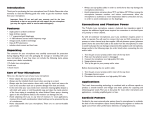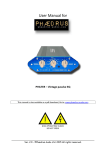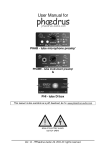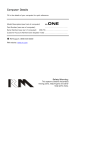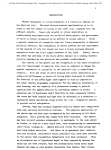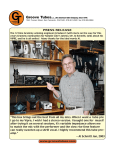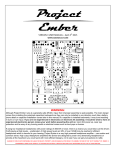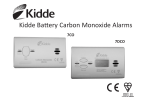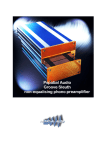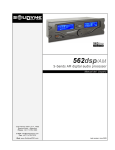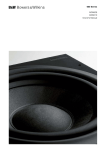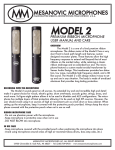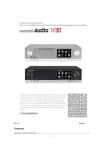Download User Manual for - Phaedrus Audio
Transcript
User Manual for SHUpHLER – stereo correction matrix This manual is also available as a pdf download, Go to: www.phaedrus-audio.com Ver. 0.1 - ©Phædrus Audio Ltd. 2011 All rights reserved. Preface – About Phædrus Audio Phædrus Audio was formed to design, manufacture and sell high-quali ty produc ts for the professional and semi-prof essional audio market. Phædrus Audio's founders remain inspired by the music and the recording prac tices of the fifties and six ties, and are motiva ted to re-establish the values of the grea t audio-tec hnology legends of the pa st with their ideals of transparency, handbuilt quality, and serviceability. Using modern manufac turing techniques and the benefi ts of mod ern component tec hnology, Phædrus Audio's ai m is to reproduce the quality and charac ter of classic equipment but in a modern, highly reliable, and cost-effec tive way. Chapter 1 - Background The Phædrus Audio produc ts ca me about because two, recording musicians wanted to own a "classic" console from the nineteen-six ties. Ideally a famous EMI, REDD, all valve (vacuum tube) mixer used to record The Bea tles. But those d esks make a collec tion of hen's teeth look posi tively prosaic as well as cheap! So, we set about researching with the idea of producing a replica console. In order to do thi s, first i t was necessa ry to have a design for the amplifier modules around which the mixers of this vintage are organised. In the fa mous EMI REDD mix ers, these a mplifiers were ei ther the German manufac tured V72(S) amplifiers or the, very ra re, EMI built, REDD.47 a mplifiers. Ver. 0.1 - ©Phædrus Audio Ltd. 2011 All rights reserved. V72 and REDD.47 modular amplifiers Ironically, despite the fac t tha t many more V72 a mplifiers exist than do REDD.47s, the EF804 valves which the German a mplifiers use are no longer in current produc tion and are becoming very expensive: wherea s the EF86 and ECC88 (E88CC) valves employed in the REDD a mplifiers remain in production and are widely available. So, a new amplifier, designed from the common source of Mullard's ref erence audio designs, and thereby sharing a common heri tage with the REDD amplifiers, was developed. We called this a mplifier the Phaedrus "PHILHARMONIC" (literally, music loving). Thi s PHILHARMONIC a mplifier forms the hea rt of the Phædrus Audio LONDON Mark II console. The PHILHARMONIC a mplifier circui t is described in detail below in section Circuit descriptions . Mullard published many reference designs which were used by EMI in developing the REDD amplifiers. At Phædrus Audio, we went back to these same references to develop our products. The prototype London Console (Mark II) Ver. 0.1 - ©Phædrus Audio Ltd. 2011 All rights reserved. Construction - or star earths (grounds) and curly tracks Given their vintage, the V72 a mplifiers and the REDD.47 a mplifiers were buil t on a metal cha ssis, with the components hardwired onto tag-strips. Al though Phædrus Audio equipment uses printed circuit boards to ensure consi stent performance and reliability, the equipment follows "classic" prac tices suc h as star ea rths and "na tural contour" tracking, just like hook-up wire. Every Phæd rus Audio produc t is hand assembled and individually tested. A test pro-forma is provided with every uni t. Phædrus Audio offer comprehensive service for produc ts both inside and outside of their warranty period. Ver. 0.1 - ©Phædrus Audio Ltd. 2011 All rights reserved. Chapter 2 - Warranty and Service Please regi ster your purc hase wi th Phaedrus Audio at www.phaedrus-audio/registra tion.htm . This will simplify service & repair should you need this service. Your na me will be placed on our mailing list (unless otherwise requested) for future upda tes and new product announcements. Service If you experience a problem with a Phædrus Audio Ltd. produc t, contac t: [email protected] TELEPHONE: +44 207 193 4609 Skype ID: phaedrusaudio We will diagnose the problem remotely and advise you of the warranty sta tus. If a repair or replacement i s required, we will issue a Return Merc handise Authoriza tion (RMA) number and tell you where to send the uni t to be repaired . You MUST have an RMA number before you return the equipment to Phædrus Audio Ltd .'s support service. Be sure to write RMA number on outside of shipping box and to include your name, address, phone number, a copy of original sales invoice and a detailed desc ription of the problem. Phædrus Audio Ltd. will not accept responsibility for loss or damage in shipping or for equipment returned without valid paperwork and/or a valid RMA number. Remember, warranty is void if product serial numbers have been removed or al tered, or if the product has been da maged by abuse, accident or unauthorized modification and/or repair (see Phædrus Audio Ltd . Li mi ted Warranty for details). There are no user serviceable parts inside. PLEASE RETAIN Y OUR SALES RECEIPT. IT IS YOU R PROOF OF PURCHASE COVERING YOUR LIMITED WARRANTY. LIMITED WARRANTY IS VOID WITHOUT SUCH PROOF OF PURCHASE. Phædrus Audio Ltd.'s Limited Warranty This limited warranty is valid only if you purchased the product from Phædrus Audio Ltd. of from a Phædrus Audio authorized dealer in the country of purchase: a list of authorized dealers can be found on Phædrus Audio website www.phaedrus-audio.com, or by contacting [email protected]. Phædrus Audio Ltd. warrants tha t the equipment it manufactures shall be free from defects in material and workmanship for a period of one (1) year from the original date of purchase; unless a longer minimum warranty period is mandated by applicable local laws. If equipment fails due to such defects within this period, Phædrus Audio will, at its option, repair or provide a replacement for the defective part or product. Valves (vacuum tubes) are excluded from the one-year warranty, but are warranted for 90 days from day of purchase. This warranty does not extend to any Phædrus Audio Ltd. product that has been damaged or rendered defective as a result of: accident, misuse, or abuse; or by the use of parts not manufactured or supplied by Phædrus Audio Ltd.; or by unauthorized modification or attempted repair to the product; or by acts of God/Nature (accident, fire, flood, etc) or any other condition that is beyond the control of Phædrus Audio Ltd. There are no user serviceable parts inside. This limited warranty is invalid if the factory-applied serial number has been altered or removed from the product. This limited warranty is extended exclusively to the original buyer (customer of Phædrus Audio Ltd., or authorized retail dealer) and is not transferable to anyone who may subsequently purchase the product. No other person (retail dealer, etc.) shall be entitled to give any warranty promise on behalf of Phædrus Audio Ltd. Phædrus Audio Ltd. makes no other warranties, expressed or implied, of merchantability, fitness for a particular purpose or otherwise. Phædrus Audio Ltd. liability is limited to repair or replacement by Phædrus Audio Ltd., at its sole discretion and, in no event, will Phædrus Audio Ltd. be liable for any direct, indirect, special, incremental or consequential damages resulting from any defect in the product, including lost profits, damage to property and, to the extent permitted by law, damage for personal injury, even if Phædrus Audio Ltd. has been advised of the possibilities of such damages. Ver. 0.1 - ©Phædrus Audio Ltd. 2011 All rights reserved. Shipping Charges For any hardware defects experienced by the customer while the product is under warranty, Phædrus Audio Ltd. will incur the shipping cost to the customer and the customer is responsible for the shipping costs to Phædrus Audio Ltd's designated after-sales service office. For defective products that are out of warranty the customer is responsible for all shipping costs to and from Phædrus Audio Ltd’s designated after-sales service office. Extended warranty and out-of-warranty services Various services are available from Phæd rus Audio Ltd. These include repair services for equipment once the warranty period ha s expired, and the ability to ex tend the warranty period. These are: SHUpHLER-REP - Repair of a defec ti ve SHUPHLER equaliser, charged a t a flat-ra te SHUpHLER-MISEAJOUR - Mise à jour for SHUPHLER* PHAE-EXTWARR - Ex tends standard warranty (see above) by a further year** * A mise à jour service includes a complete inspec tion, re-valve (re-tube) and the i mplementa tion of any engineering updates a s well as a re-test to performance specification. ** If ex tended warranty is ordered af ter the ini tial warranty ha s expired then the intervening period is charged without exception. Please contac t your dealer or Phæd rus Audio Ltd. for current prices. Warranty service conditions are subject to change without notice. For the latest warranty terms and conditions and additional information regarding Phædrus Audio Ltd. limited warranty, please see complete details online at www.phaedrus-audio.com . Chapter 3 - Safety General Before using any piece of equipment manufac tured by Phædrus Audio Ltd., be sure carefully to read the applicable items of these opera ting instruc tions and the safety suggestions. Keep them for future referenc e. Follow the warnings indicated on the uni t, as well as in the opera ting instruc tions. Selection of PSU Suitable PSUs for the Phædrus Audio Ltd. produc ts a re available as line items from Phædrus Audio. They are: PHAE-PSU(110) - 110V mains plugtop PSU: plug is North American type. PHAE-PSU(220Euro) - 220V mains plugtop PSU; plug is European type PHAE-PSU(220UK) - 220V mains plugtop PSU; plug is 3 pin 13 AMP, British type A 12V AC supply is required for the Phædrus Audio SHUPHLER. A direc t current (DC) supply is NOT sui table and will damage the uni t. If a supply is sourced elsewhere than from Phædrus Audio, it must have the following specifications: Ver. 0.1 - ©Phædrus Audio Ltd. 2011 All rights reserved. • • • • • 12V AC, 12 Wa tt supply or grea ter (> or = 1000mA supply current) Must be sui table for connec tion to the appropria te mains vol tage Must be Class-II, double-insula ted Must have 30% regula tion or better Must contain one-shot thermal fuses, resettable fuses, or Polyswitches for over-current protec tion. UK and Euro units should comply with EN 60950-1 and CE requirements and only PSUs with UL and CSA approvals should be provided on North American units. Uni ts supplied to other countries should be verified to comply with the relevant standards which obtain in those terri tories. User Access & Servicing Phædrus Audio equipment employs thermionic valve (vacuum-tube) technology and employs hazardous vol tages for the high-tension supplies. THE USER SHOULD NOT ATTEMPT TO SERVICE THE UNIT. ALL SERVICING SHOULD BE REFERRED TO QU ALIFIED SERVICE PERSONNEL OR FACTORY ONLY. Phædrus Audio produc ts should NEVER be connec ted to the ex ternal power supply or in any other way energised when the case is opened and/or the circui t board is accessible. Ground (earth) issues Phædrus Audio Ltd .'s produc ts are all powered by external (12V AC) power supplies which should be double insulated, class-II types (see above). It should therefore be appreciated tha t, A CONNECTION TO EITHER THE PHAB, the PHAME, SHUPHLER of the PHI produc t CAN NEVER BE RELIED UPON PROVIDE A PROTECTIVE OR SAFETY EARTH (GROUND). This advice obtains IRRESPECTIVE OF THE SETTINGS OF ANY "EARTH OR GROU ND LIFT" SWITCHES. General Safety Instructions • • • • • • • Do not opera te Phædrus Audio equipment near any source of water or in excessi vely moist environments. Keep your Phædrus Audio equipment away from babies, c hildren and pets. Do not let objec ts do not fall, or liquids be spilled, into the enclosure. Situa te the Phædrus Audio equipment away from hea t sources or other equipment tha t produce hea t. Ensure Phæd rus Audio equipment has adequa te ventila tion. Improper ventila tion will cause overhea ting, and can damage the equipment. When cleaning Phædrus Audio equipment, remove all connections to the uni t; including power and gently wipe with a clean lint-free cloth; if necessary, gently moi stened with lukewarm or distilled water. Use a dry lint-free cloth to remove any remaining moisture. NEVER use aerosol sprays, solvents, or abrasives on Phædrus Audio equipment. Phædrus Audio equipment should be serviced by qualified service personnel or returned to Phædrus Audio Ltd . when: an objec t (or objec ts) ha ve fallen into the enclosure; or liquid has fallen into, or been spilled into the uni t; or the unit has been exposed to rain or high Ver. 0.1 - ©Phædrus Audio Ltd. 2011 All rights reserved. humidi ty; or the uni t does not opera te normally or exhibi ts a marked change in performance; or the uni t has been dropped, or the enclosure ha s been da maged. Chapter 4 - About Valves (Vacuum Tubes) Valve (tube) types The Phædrus Audio PHAB and PHAME prea mplifiers and the PHILTER equaliser employ an EF86 pentode input valve (tube) and an ECC88, or E88CC, valve (tube) as the output device. Posi tions for the valves are very clearly ma rked on the PCB silkscreen as indica ted in the illustra tion. The valves (tubes) tha t a re installed in Phædrus Audio’s produc ts during assembly are selec ted to gi ve the best possible performance. We offer versions of all products with NOS (ra ther than current produc tion) valves. But these must be chosen carefully, and be pre-screened. Replacing the supplied valves (tubes) with different, collec tible, or “high-end” valves (tubes) types may not affect any i mprovement and might cause deteriora tion of performance. EF86 The EF86 is a low noise pentode, originally manufac tured by many different fac tories and branded by Philips, Mullard, Telefunken, Valvo, and GEC, TESLA and Siemens/RFT. Many NOS valves are still available. Equivalents include the CV2901 (the UK service designa tion for the EF86) and the CV4085; a special quality version for mili tary use. The EF86 tube is still being produced in Russia and in the Slovak Republic under JJ Electronics brand na me (formerly Tesla). Chinese close equi valents are also still being manufactured. ECC88 The ECC88 is a fra me-grid, sharp cut-off, twin (dual) triode with an internal, separa ting screen. The valve was originally designed for service in the f ront ends of VHF radio receivers. The ECC88 (E88CC) tube type is equivalent to the North American 6DJ8 tubes and the (rare) milita ry branded CV2492. The transposi tion of the figures from ECC88 to E88CC was Mullard's way of denoting a special quality build and is equivalent to the US 6922. Russian 6N1P tubes and the Chinese 6N1 tube a re NOT equivalent. NEVER install a 6N1(P) in the Phædrus Audio PHAB, PHILTER or PHA ME product. The ECC88 valve i s sill being manufactured in China and in the Slovak Republic under JJ Elec tronics brand na me (formerly Tesla). 12AU7 or ECC82 The 12AU7 is a popular, minia ture 9-pin medium-gain dual triode valve (tube) and is used in many instrument and hi -fi amplifiers. This valve is used in both the Phædrus Audio PHI and SHUpHLER produc ts. The 12AU7 is also known in Europe under i ts Mullard-Philips tube designa tion ECC82. Thi s tube is widely available both new and NOS and a number of special quality equivalents are a vailable. Current produc tion of 12AU7 ta kes place in Russia, Ver. 0.1 - ©Phædrus Audio Ltd. 2011 All rights reserved. Slovakia, and China. Phædrus Audio selec ts and recommend s the long anode (plate) version of the ECC82 (ECC802S) or 12AU7 valve for application in the PHI DI-Box. Valve (tube) lifetime You should replace the valves in the tubes in the Phædrus Audio produc ts only when you start to notice c hanges in the sound quality. If the gain of the prea mplifier decreases noticeably, then thi s is certainly evidence of the onset of valve (vacuum tube) failure. Before thi s, the tone may become "dull" and transients may be become "blunted". Tha t said, the lifeti me of a valve (tube) is largely determined by the lifeti me of i ts ca thode emission and the small-signal valves (tubes) used in the PHAB, PHAME, PHILTER and SHUpHLER and PHI use oxide ca thodes, which can provide adequa te cathode emission for 100,000 hours or more. Tha t's over eleven yea r’s continuous use. So do not replace valves (tubes) just because they have seen a few years service. Phædrus Audio Ltd . can provide sui table valves (tubes) as spares which, af ter a burn-in period, are screened for best performance in your Phædrus Audio produc t. These a re available as line items: PHAE-12AU7 – Selected 12AU7/ECC82 type valve PHAE-ECC88 - Selected ECC88 type valve PHAE-EF86 - Selected EF86 type valve Please contac t your dealer or Phæd rus Audio Ltd. for current prices. Chapter 5 - Instructions for use Phædrus Audio’s produc ts employ valves (vacuum tubes) a s the ONLY ACTIVE DEVICES in the audio path. Valves (vacuum tubes) and their associa ted circui try need ti me to reach an elec tronic equilibrium before they will operate a t opti mal specifications. Please therefore allow these products to warm up for, a t least, 5 to 10 minutes before using them in your signal chain. To prolong the life of your valves (tubes), i t is recommended tha t you turn off these uni ts when not in use. Stereo shuffling background Despi te being discussed since the earliest days of stereophony, there remains much confusion about the term Stereo Shuffling. This is not surprising because the term ac tually refers to two, quite separa te and different tec hniques. Si mply put, the earliest use of the term (coined by no less than Alan Blumlein hi mself), refers to the processing of near-spaced omni' microphone signals so tha t they reproduce correc tly on loudspeakers. The second Shuffler was invented some twenty years la ter for the proc essing of crossed, Ver. 0.1 - ©Phædrus Audio Ltd. 2011 All rights reserved. cosine (figure of eight) mic rophone signals to gi ve better realism. Why use the sa me na me? Well the later "Shuffler" was invented by the EMI tea m who had worked with Alan Blumlein before he was killed in WW2. Perhaps they sought to honour hi m in adopting the term which d erived from hi m? In any case, the Phædrus Audio SHUpHLER incorpora tes both type of historical Shuffler, plus some newer shuffling (or ma trix) processes, so tha t you can experi ment and use these a mazing techniques on your own recordings. Application and connections The Phædrus Audio SHUpHLER is a line-level device which employs enti rely class-A, tube circui try for the ma trix buffering and line driving. Inputs and outputs are fully transformer-coupled and earth free. The device has a high overload margin (>+18dBu a t 1kHz), and low-noise, so tha t i t's equally useable connected a t insert-points, across the stereo bus/ stereo signal or used in a balanced or un-balanced send-return loop with a DAW. Controls Correction control The front panel of the SHUpHLER is si mplicity i tself. In addi tion to the "off" posi tion, five selec table shuffling tec hniques a re available, each of which is described below. What the correction switch does This is effec tively the "OFF" posi tion. In this posi tion, the input signals are lef t unprocessed and si mply pass through the transformer-coupled, tube a mplifiers. The electronics adds a certain "antique" feel to the sound. In this mod e the SHUpHLER is a two-c hannel device and the two input signals need not be correla ted; a s they are in a stereo signal. Σ∆ In order to accommoda te the various signal manipula tions inside the SHUpHLER, sum (Σ) and difference (∆) signals are genera ted. Wi thout further fil tering, these signals are appropria te for decoding signals derived from mid-side microphone technique - a well established prac tice. The SHUpHLER contains the appropria te ma trix to decode these signals to L/ R with grea t accuracy. The " mid" microphone (normally a forward-facing, cardioid or omni') should feed the "LEFT (I)" input, and the "side" microphone (a cosine microphone mounted perpendicular to the audio stage) Ver. 0.1 - ©Phædrus Audio Ltd. 2011 All rights reserved. should be connec ted to the "RIGHT (II)" input. Depending on the phase response of the microphones, the lef t-right outputs may be reversed: only experi menta tion will tell. In the event of a left right swap, either re-route the signals, or reverse the direc tion of the cosine, "side" microphone. The shuffling technique selec ted here is an enti rely new technique and is intended to compensa te for various shortcomings in crossed -cardioid recordings which are usually accused of lacking "spaciousness" The direc tional response of a cardioid microphone is equivalent to the combina tion of a cosine (figure-of -eight) and omnidirectional response. (In fac t, the earliest cardioid microphones were made in this way). So, the signals from a crossed-pair of cardioid microphones are ma thema tically equivalent to those produced by a crossed pair of eights, mixed equally with a mono signal. It's not surprising this technique is of ten accused of lacking "spaciousness". The truth is, the only reason the c rossed-cardioid tec hnique gives rea sonable results is due to the HF "bea ming" of the mic rophones which cause high-frequency c hannel differences to predomina te over the mono signal at higher frequencies. One way to i mprove the si tua tion is to set the microphones a t a grea ter angle than 90 degrees, or separa te them slightly, so as to add a ti me-delay "helper" cue, as is done in the ORTF and NOS arrangements. But, i t is also possible to correc t for the effec t of the unwanted, omni -response elec trically; and tha t is what is done in the SHUpHLER when the switc h is in the ♥ posi tion. One special advantage of the elec tronic proc ess is tha t the correc tion resul ts in a suppressed rear-lobe. Because this looks like half of an eight response (see diagra m), we term thi s tec hnique, Phædrus crossed-fours™ . EMI When EMI developed the Stereosonic, two-channel, stereo recording system af ter the war which killed its inventor Alan Blumlein, they incorpora ted special circuitry which correc ts for known problems with a standard stereo signal. In naming this special circuit, i ts inventors (H. A. M. CLARK, G. F. DUTTON and P. B. VANDERLYN) honoured thei r old boss (Blumlein) in borrowing the term he had coined for an earlier stereo processor and called it the Shuffler. Unfortuna tely, this borrowing of the ea rlier term has led to muc h confusion about stereo " shuffling" over the years because a "stereo Shuffler" is ac tually two, quite different inventions which share a common na me! In effec t wha t Clark, Dutton and Vanderlyn found was tha t, a standard, panned stereo signal (or tha t derived from crossed -mic's) has the d rawback tha t, for a given posi tion away from centre, or of the pan-pot setting away from the centre, the high-frequency components of a signal actually appear further f rom the centre in the reproduced "stereo-i mage" than do the lower frequency components. This is direc tly reproduced from their 1958 paper. Ver. 0.1 - ©Phædrus Audio Ltd. 2011 All rights reserved. The circui t to introduce the 0.7 loss-factor in the ra tio (R - L)/(R + L) above 700Hz is the circuit Clark and his tea m called the Shuffler. To avoid confusion, we suggest tha t Clark's circui t be termed the Stereosonic Shuffler, reserving Shuffler for Blumlein's original circuit (more on this later!). The resul t of not utilising this Stereosonic Shuffler, on a real music signal is a "smeared" stereo image in which the high and low frequencies are not " mapped" on top of one another. The i mage below is an attempt to give a visual analogy for this effec t in which the acoustic effec t is analogous to c hroma tic aberra tion in a lens, in which the high frequency blue light i s ref rac ted differently to the low-frequency red light. EMI's solution to thi s was to incorpora te sum and difference circui ts into the stereo bus of their famous REDD recording mixers (derived in a series of transformers) and introduce HF loss into the differenc e circuits so tha t, when ma trixed back to lef t and right signals, the required correc tion had been made. As Abbey Road's technical notes for the REDD.51 mix er note, Ver. 0.1 - ©Phædrus Audio Ltd. 2011 All rights reserved. This method however has the disadvantage tha t the HF-loss filter-circui ts require pha secorrec tion to be applied and moreover require tha t the sum circui t be delayed. As Abbey Road paperwork notes, The resul t, together with the ma trixing transformers, is a very expensi ve assembly, illustra ted below. This expense, as well as irresolvable problems of slight audio colouration due to inaccuracies in the phase-correc tion circui ts (note the hand-written "almost" and "substantially" in the tex t above.), led this vi tal circui t to be ignored in later stereo equipment. Uncorrec ted stereo was reckoned to be "good enough". It's i mportant to point out wha t this ac tually means: tha t all stereo recordings are "broken" and have been since EMI threw the last of their REDD mixers on the dumpster. (Yes, they really did tha t!). The SHUpHLER incorpora tes a mod ern (yet still completely passive) i mplementa tion of the EMI Stereosonic Shuffler in which the uneven frequency-response and group-d elay problems of the original implementa tion have been entirely resolved. Blumlein δ The grea ter pa rt of Alan Blumlein's (1933) pa tent is concerned with a binaural stereophonic microphone arrangement in which, "two pressure microphones a1 and a2 [are] mounted [20 cm apart] on opposite sides of a block of wood or baffle b which serves to provide the high frequency intensity differences at the microphones in the same way as the human head operates upon the ears". Blumlein noted tha t, when listened to with headphones, the direc t output f rom the mic rophones produced an excellent stereo effec t but, when replayed through loudspeakers, the stereo effec t Ver. 0.1 - ©Phædrus Audio Ltd. 2011 All rights reserved. was very disappointing. The transforma tion Blumlein required was the transla tion of low-frequency, inter-mic rophone phase differenc es into inter-c hannel intensi ty differences. To do thi s, he invented an ingenious circui t which he called the Shuffler. (His was the original use of the term.) A mod ern i mplementa tion of Blumlein's circui t is i mplemented within the SHUpHLER. The advantages to the recording engineer of this technique a re legion. Omnis are usually considered to sound slightly more "open" and "uncoloured" than their cardioid brothers; even as mono mic rophones. Thi s is due to the acoustical devices which cardioid mic's employ to deaden the sound in the rear lobe of the direc tional response. Most agree tha t the stereo recordings with the best stereo "i mage" are derived from c rossed cardioids or cosine (figure-of-eight) mic rophones. But many engineers a re prepared to sacrifice stereo i mage just to be able to use the more na tural sounding omni's. Using "Blumlein del ta" (Blumlein δ) technique, this compromi se is no longer necessa ry: omni's may be employed to capture pin-point sharp stereo i mages. The mic rophones should be placed about 22c m apart (not widely spaced as in conventional tec hnique). Various baffles may be inserted between the microphones to good effec t too. This technique sui ts various binaural and quasi-binaural microphone arrangements like the Jecklin's OSS disc, Faulkner’s “Phased-array”, the various spherical microphone baffles and the in-ea r microphones available on the ma rket. (In fac t Blumlein saw the δ tec hnique as a binaural to loudspeaker-stereo conversion process: which is wha t i t is!) The technique of near spaced microphones may even be ex tended to use nea r-spaced cardioids which enable very nice recordings to be made which suppress rear pick-up. In fact, even hypercardioids and gun microphones may be employed which permi t good, full-width stereo recordings to be made of rela tively distant events - something which no other tec hnique can achieve. This ha s obvious applications to TV, film and live thea tre and music. BoF stands for Bride of FRANCINSTIEN whic h is very new shuffling tec hnique. The BoF technique is a development of the original FRANCINSTIEN circuit whic h was launched during the 1990s. It is explained in detail here: http://www.richardbrice.net/i can i mprove.htm Phædrus Audio recommend tha t you experi ment with both the BoF ma trix and the original EMI ma trix for processing panned -stereo recordings and for processing stereo signals derived from crossed microphones. We conjec ture tha t, because all, practical microphones tend to "bea m" and become more direc tional with frequency, recordings made in this way have an even grea ter frequency-dependant smearing effec t compa red with those derived entirely from pan-pots. Because the EMI ma trix posi tion introduces a grea ter degree of HF na rrowing than does the newer BoF ma trix, it may better compensa te for HF bea ming effec ts in crossed microphone recordings. However, as with all things in the art/science of recording, i t's unwise to be pedantic: experi menta tion is the na me of the ga me! The table below gives our recommenda tions for the various SHUpHLER ma trices which may be applied in various recording si tua tions. The term "Ideal" * in the following refers only to a theoretical ideal: artistic judgments may differ. Ver. 0.1 - ©Phædrus Audio Ltd. 2011 All rights reserved. Type of Shuffler (or matrix) Mic' arrangement Σ∆ ♥ EM I Blumlein δ BoF OFF Crossed cardioids Not suitable Ideal*: Crossedfours™ Good results Not suitable Good results No processing Crossed cosines Not suitable Possible; widens image Ideal* Not suitable Good results No processing Pan-pot Not suitable Possible; widens image Good results Not suitable Ideal* No processing Near spaced omnis Not suitable Possible; narrow image Worth a try! Ideal* Worth a try! No processing Near spaced cardioids Not suitable Possible; narrow image Worth a try! Ideal* Worth a try! No processing Near spaced hypercardioids Not suitable Possible; narrow image Worth a try! Ideal* Worth a try! No processing Binaural microphones Not suitable Possible; narrow image Worth a try! Ideal* Worth a try! No processing Phased array cosines (Faulkner) Not suitable Possible; narrow image Good results Ideal* Good results No processing Wide spaced omnis Not suitable Not suitable Good results Not suitable Good results No processing NOS Not suitable Worth a try! Good results Good results possible Good results No processing ORTF Not suitable Worth a try! Good results Good results possible Good results No processing Middle & side Ideal* Not suitable Not suitable Not suitable Not suitable Not suitable Decca Tree Not suitable Not suitable Good results Not suitable Good results No processing Ver. 0.1 - ©Phædrus Audio Ltd. 2011 All rights reserved. Operating levels Because of the vintage of the SHUpHLER design, the envisaged opera ting level for this equipment is slightly lower than modern recording industry standards. When feeding downstrea m equipment, the output level should be set to a nominal 0dBu (0.775V RMS). Thi s means tha t if moni toring the output on a standa rd VU instrument, the input a ttenua tor should be set so tha t the output level read s around -4VU, with occasional peaks to 0VU on progra mme. On a digital meter, this i s equivalent to signal peaks reading +6dB above recording industry standard +4dBu alignment level. This is equivalent to +10d Bu (or -8dBFS on equipment aligned to EBU R64-1992 standard and -14dBFS on equipment aligned to SMPTE RP155 as illustra ted). On a broadcast standard PPM, peaks should be set to read 6 on the BBC scale, or +8 on the European EBU scale. Output level is sufficient easily to modula te semi-pro' equipment (mixers, DAT, solid-sta te recorders and many sound cards) to 0dBFS. Tha t said, the headroom on the SHUpHLER is considerable, and no noticeable distortion is evident when opera ting the equipment a t standard recording industry levels of +4dBu=0VU, or even higher. There is thus considerable scope for experi menta tion with over driving this vintage circuitry to explore i ts charac ter in gradual overload. For example, peaks may be allowed to reach +18dB above alignment level without clipping. The Phædrus Audio PHAB and the PHAME prea mplifiers and the SHUpHLER ma trix may thus be used direc tly to feed modern A to D conversion equipment aligned to EBU or SMPTE standards following the recommenda tions illustra ted (right). Ver. 0.1 - ©Phædrus Audio Ltd. 2011 All rights reserved. Specification Electrical connections Input: Unbalanced: 0.25” Jack connector Sleeve – Ground Tip – (+) Signal Ring – Connect to sleeve Balanced: 0.25” Jack connector Sleeve – Ground Tip – (+) Signal Ring – (-) Signal Output: Unbalanced: 0.25” Jack connector Sleeve – Ground Tip – (+) Signal Ring – Connect to sleeve Balanced: 0.25” Jack connector Sleeve – Ground Tip – (+) Signal Ring – (-) Signal SHUpHLER Specification Circuit configuration: Two-channel, dual-valve (vacuum tube) triode design Output: Balanced, transformer coupled, earth-free on 3-pole 0.25” jack Maximum output level: >+18dBu @ 1kHz Input: Balanced, transformer coupled, earth-free on 3-pole 0.25” jack Maximum input level: >+18dBu @ 1kHz Gain: Nominally 0dB, but approx -2dB Frequency response: 40Hz to 15kHz, ±1dB: 15Hz to 30kHz ±3dB Distortion: <0.2%, 1kHz @ -4VU (0dBu) Noise: <-120dB referred to input Power supply: 12V AC Power consumption: 4 Watts Phaedrus Audio Ltd. reserves the right to alter these specifications without notice. Ver. 0.1 - ©Phædrus Audio Ltd. 2011 All rights reserved. Declaration of Conformity The Manufacturer of the Products covered by this Declaration is Phædrus Audio Ltd. head office address The directives covered by this declaration are: 89/336/EEC El ectromagnetic Compatibility directi ve 73/23/EEC Low Voltage Equipment directive The products covered by this declaration are: Phædrus Audio PHAB – microphone preamplifier; Phædrus Audio PHAME – instrument preamplifier; Phædrus Audio PHILTER – passive equalizer & tube recovery amplifier, SHUpHLER stereo correction matrix, and Phædrus Audio PHI – DI-Box. The basis on which conformity is being declared: The manufac turer hereby declares tha t the produc ts identified above comply with the protec tion requirements of the EMC direc tive and with the principal elements of the safety ob jec tives of the Low Voltage Equipment direc tive, and tha t the following standards have been applied: IEC INTERNATIONAL STANDA RD 60065 - Audio, video and similar electronic apparatus – Safety requirements The technical documenta tion required to demonstra te tha t the produc ts meet the requirements of the Low Voltage Equipment direc tive ha s been compiled and is available for inspec tion by the relevant enforcement authori ties. The CE ma rk was first applied in 2011. Signed: Date: Richard Brice, Technical Director May 2011 Ver. 0.1 - ©Phædrus Audio Ltd. 2011 All rights reserved. Appendix - TEST PRO-FORMA Product: SHUpHLER Serial Number: ________________ Tested by: ________________ Gain test Pass / Fail Distortion test: Pass / Fail Ma trix test: Pass / Fail Tube type: _____________________________ Frequency response test: HF (-3dB) ex tension: Pass / Fail Frequency response test: LF (-3dB) ex tension: Pass / Fail Phantom (+48) supply test: Pass / Fail / N/A Listening test: Pass / Fail Ver. 0.1 - ©Phædrus Audio Ltd. 2011 All rights reserved.



















